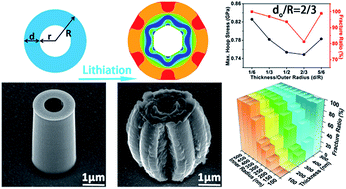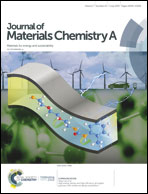Anisotropic expansion and size-dependent fracture of silicon nanotubes during lithiation†
Abstract
Silicon nanotube anodes are notably promising for high-performance lithium-ion batteries due to their outstanding structural stability, but fundamental understanding about their structural evolution during lithiation still remains unclear. Here, the expansion and fracture behavior of lithiated silicon nanotubes is investigated, and the influences of the crystal phase, crystal orientation, inner radius, wall thickness, and thickness–radius ratio are demonstrated. Experiments and simulations demonstrate anisotropic expansion and outer-surface fractures of crystalline silicon nanotubes and isotropic expansion of amorphous ones. The inner holes of nanotubes undergo much less expansion than the outside. The fracture ratio and the maximum hoop stress are positively correlated with both wall thickness and inner radius for crystalline silicon nanotubes. Their competition gives rise to an optimal thickness–outer radius ratio of about 2/3, and the critical diameter reaches 700 nm correspondingly. This research provides significant insight into the lithiation behavior of silicon nanotubes, which could help to design improved silicon anodes.



 Please wait while we load your content...
Please wait while we load your content...